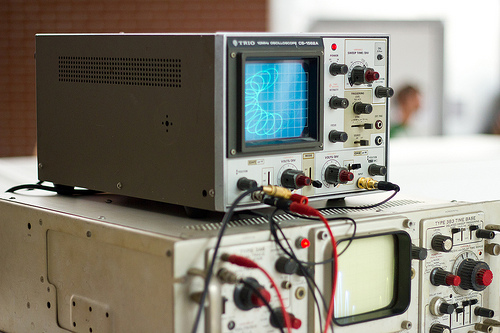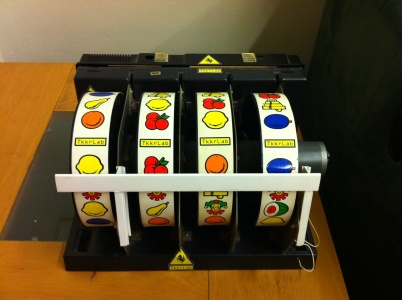OSC Databending
From
For the databending event during GOGBOT 2011 Tkkrlab contributed several projects. Purpose of the Databending event was to connect many art / technology installations together. More examples on databending workshops page.
Contents
Protocol
The OSC protocol is just a way to build messages, although the network protocol is used most often. The contents of the messages and / or the relation between senders and receivers is not described. The communication structure was defined as follows:
* Protocol on Google Docs
Projects
Oscilloscope Control
OpenFrameworks
Sourcecode: File:OscilloscopeControl.tar.bz2 Requires: Oscilloscope with XY input, OpenFrameworks 0.07, PC with soundcard
This software was written (badly) for OpenFrameworks. It uses Henri's Spirograph functions to show spirograph figures on an oscilloscope. No parameters are written to the network (apart from identification / keepalive) Four parameters are read:
* Wheel / ring ratio * Hole number * size X * size Y
The code ensures that something interesting is shown on the oscilloscope for all combinations of input parameters by limiting the scopes of the variables.
CSound
The .csd csound-file below is a databendable version. It contains two instruments, the first one uses only one wheel but you can vary the output by gat,fase,wiel,fase2, and figs
- gat: hole in spirograph wheel
- fase: rotate figure
- wiel: spirograph wheel
- fase2: rotation of subsequent figures
- figs: number of figure to draw
The second instrument draws predefined spirograph figure where yoy can only vary 'gat' and 'fase'. qutecsound (available as a ubuntu package) is a nice IDE for playing with CSound.
<CsoundSynthesizer>
<CsOptions>
; Select audio/midi flags here according to platform
; Audio out Audio in
-odac -iadc ;;;RT audio I/O
; For Non-realtime ouput leave only the line below:
; -o gen10.wav -W ;;; for file output any platform
</CsOptions>
<CsInstruments>
#define WIEL #"/csound-spiro/in/wiel"#
#define GAT #"/csound-spiro/in/gat"#
#define FASE #"/csound-spiro/in/fase"#
#define FASE2 #"/csound-spiro/in/fase2"#
#define FIGS #"/csound-spiro/in/figs"#
#ifndef OSCSERVER
;#define OSCSERVER #"127.0.0.1"#
#define OSCSERVER #"mansoft.nl"#
#end
; Initialize the global variables.
sr = 44100
kr = 441
ksmps = 100
nchnls = 2
gilisten OSCinit 7000
turnon 11
instr 11
OSCsend 1, $OSCSERVER, 8000, "/csound-spiro/out/inputs", "s", "gat,fase,wiel,fase2,figs"
endin
; Instrument 1
; figuren met hetzelfde wiel
; luistert naar alle OSC boodschappen
instr 1
kwiel init 30
iamp init 32000
irr init 3.05
ifactor init 9
ifreq init kr / ifactor
iringidx init p4
iring table iringidx, 6
kcnt init 0
kgat init 0
next1:
kans1 OSClisten gilisten, $GAT, "f", kgat
if (kans1 == 0) goto done1
; printks "gat = %f\\n", 0, kgat
kgoto next1 ;Process all events in queue
done1:
kfase init 0
next2:
kans2 OSClisten gilisten, $FASE, "f", kfase
if (kans2 == 0) goto done2
; printks "fase = %f\\n", 0, kfase
kgoto next2 ;Process all events in queue
done2:
kwiel1 init 0
next3:
kans3 OSClisten gilisten, $WIEL, "f", kwiel1
if (kans3 == 0) goto done3
; printks "kwiel1 = %f\\n", 0, 16 * kwiel1
kgoto next3 ;Process all events in queue
done3:
kfase2 init 0.5
next4:
kans4 OSClisten gilisten, $FASE2, "f", kfase2
if (kans4 == 0) goto done4
; printks "fase2 = %f\\n", 0, kfase2
kgoto next4 ;Process all events in queue
done4:
kfigs init 0.3
next5:
kans5 OSClisten gilisten, $FIGS, "f", kfigs
if (kans5 == 0) goto done5
; printks "figs = %f\\n", 0, kfigs
kgoto next5 ;Process all events in queue
done5:
kwiel table 16 * kwiel1, 3
krondjes table 16 * kwiel1, iringidx + 4
kfreq = ifreq * krondjes
kwr = kwiel / iring
ka = 1 - kwr
ktblidx = kcnt / ifactor % floor(kfigs*10)
kcnt = kcnt + 1
apha1 phasor kfreq
kfase2a = kfase2 * 4 - 2
afase1 = apha1 + ktblidx * kfase2a / iring + kfase
apha2 phasor kfreq * (kwr - 1) / kwr
afase2 = apha2 + ktblidx * kfase2a / iring + kfase
kb = kwr - (0.0647059 * (ktblidx + kgat * 10.0 - 1.0) + 0.31) / irr
a1 table afase1, 1, 1, 0, 1
a2 table afase2, 1, 1, 0, 1
a3 table afase1, 2, 1, 0, 1
a4 table afase2, 2, 1, 0, 1
outs iamp * (a1 * ka + a2 * kb), iamp * (a3 * ka + a4 * kb)
endin
; Instrument 2
; vaste figuren gedefinieerd in tabellen
; luistert naar 'gat' en 'fase' OSC boodschappen
instr 2
ifreq init kr
kgat init 0
next1:
kans1 OSClisten gilisten, $GAT, "f", kgat
if (kans1 == 0) goto done1
; printks "gat = %f\\n", 0, kgat
kgoto next1 ;Process all events in queue
done1:
kfase init 0
next2:
kans2 OSClisten gilisten, $FASE, "f", kfase
if (kans2 == 0) goto done2
; printks "fase = %f\\n", 0, kfase
kgoto next2 ;Process all events in queue
done2:
done3:
iringidx init p4
iring table iringidx, 6
ifig init p5
iaantalwielen init p6
iamp init 32000
irr init 3.05
kcnt init 0
ktblidx = kcnt % iaantalwielen
kcnt = kcnt + 1
kwielidx table ktblidx, ifig
kgat1 table ktblidx, ifig + 1
kfase1 table ktblidx, ifig + 2
kwiel table kwielidx, 3
krondjes table kwielidx, iringidx + 4
kfreq = ifreq * krondjes
kwr = kwiel / iring
ka = 1 - kwr
apha1 phasor kfreq
afase1 = apha1 + kfase + kfase1 / iring
apha2 phasor kfreq * (kwr - 1) / kwr
afase2 = apha2 + kfase + kfase1 / iring
kb = kwr - (0.0647059 * (kgat1 + kgat * 10.0 - 1.0) + 0.31) / irr
a1 table afase1, 1, 1, 0, 1
a2 table afase2, 1, 1, 0, 1
a3 table afase1, 2, 1, 0, 1
a4 table afase2, 2, 1, 0, 1
outs iamp * (a1 * ka + a2 * kb), iamp * (a3 * ka + a4 * kb)
endin
</CsInstruments>
<CsScore>
; cosinus tabel
f 1 0 16384 11 1
; sinus tabel
f 2 0 16384 10 1
; *** lookup-tables
; wielen
; 0 1 2 3 4 5 6 7 8 9 10 11 12 13 14 15
f 3 0 16 -2 24 30 32 36 40 45 48 52 56 60 63 64 72 75 80 84
; aantal rondjes bij ring 96
f 4 0 16 -2 1 5 1 3 5 15 1 13 7 5 21 2 3 25 5 7
; aantal rondjes bij ring 105
f 5 0 16 -2 8 2 32 12 8 3 16 52 8 4 3 64 24 5 16 4
; ringen
f 6 0 2 -2 96 105
; *** figuren
; wielen
f 10 0 8 -2 0 14 14 14
; gaten
f 11 0 8 -2 5 13 14 15
; fases
f 12 0 8 -2 0 0 0 0
; wielen
f 13 0 16 -2 1 1 1 5 5 5 9 9 9 13 13 13
; gaten
f 14 0 16 -2 1 2 3 6 7 8 11 12 13 16 17 18
; fases
f 15 0 16 -2 0 0 0 0 0 0 0 0 0 0 0 0
; wielen
f 16 0 32 -2 4 8 14 12 0 2 11 6 14 12 0 2 11 6 12 0 2 11 6 2 11 6 6 6
; gaten
f 17 0 32 -2 5 9 15 13 1 3 11 7 15 13 1 3 11 7 13 1 3 11 7 3 11 7 7 7
; fases
f 18 0 32 -2 0 0 0 0 0 0 0 0 8 8 8 8 8 8 16 16 16 16 16 24 24 24 32 40
; wielen
f 19 0 16 -2 1 1 1 1 1 5 5 5 5 5 9 9 9 9 9
; gaten
f 20 0 16 -2 1 2 3 4 5 1 2 3 4 5 1 2 3 4 5
; fases
f 21 0 16 -2 0 0 0 0 0 0 0 0 0 0 0 0 0 0 0
; wielen
f 22 0 8 -2 9 9 9 9 9 9 9 9 9
; gaten
f 23 0 8 -2 1 2 3 2 3 4 5 4 5
; fases
f 24 0 8 -2 0 0.5 1 -0.5 -1 1.5 2 -1.5 2
; 10000 keer herhalen
r 100
; een wiel
;ins start dur ring
i1 0 30 0
i1 + . 1
; vaste figuren
;ins start dur ring fig aant
i2 60 5 1 10 4
i2 + . 1 13 12
i2 + . 0 16 24
i2 + . 1 19 15
i2 + . 1 22 9
s
e
</CsScore>
</CsoundSynthesizer>
LasVegas
LasVegas slot machine controlled by OSC
Floppy Jukebox
Floppy Jukebox Music from floppy drives with discolights controlled by OSC
Csound Drone
Csound is a language to describe waveforms (orchestras) and music scores. It supports OSC. Csound Drone based on a Csound program by Michael Gogins which is controllable via a Python script. The original program is part of his Csound Algorithmic Composition Tutorial. Two versions are available: Csound Drone for Android Fingerplay and Csound Drone for Databender
Csound Drone for Android Fingerplay
Csound Drone for Android Fingerplay is a OSC server which can be controlled the Android OSC client Fingerplay. The Fingerplay parameters are:
/fingerplay/control/2 /fingerplay/control/3 /fingerplay/control/5 /fingerplay/control/6
which corresponds to the XY-pads of Fingerplay. They are coupled to the following Csound Drone parameters:
kdistortfactor kfeedback kharmonic kdisttable
OSC to DMX
DMX control from linux
- If DMX is controlled by a http://rs485-rs422.com/ USB to DMX cable then you can control it with the libftdi to send DMX command's. - libftdi also be use on a OpenWRT linux based. - User:Hfmanson has dmxconsole.c modified to work with libftdi. Sources soon.
OSC to DMX programma
User:Hfmanson wrote udpserv100fat.c that also use libftdi to listen to a UDP poort for a OSC messages a la 100% FAT and send them to a DMX device.
OSC mix panel
During the databending event we used Heinze's tool for connecting the devices. User:Hfmanson has developed a web version of this tool. With this java webaplication databending devices can be controlled, a device has to register with this webapplication and the user can control all the devices via a realtime interactieve webpage. Used technologies are Ajax en HTML5 Server Sent Events.
Ajax is used for changing OSC devices or users (e.g. connecting in- and output devices). Server Sent Events for pushing of OSC output data (eg. jostick values). see http://mansoft.nl:8080/sse/osc.html.
OSC and Python
Also see OSC_Python page for more examples.


